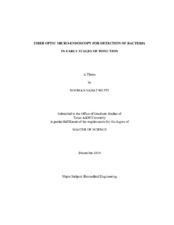| dc.description.abstract | Mycobacterium tuberculosis, the bacterium that causes tuberculosis, has an incubation period ranging from a few months to several years following infection via inhalation into the lungs. Whole body fluorescence scanners are used to image and monitor the growth of fluorescent protein expressing strains of M. tuberculosis in the lungs of animal models. Accurate quantitative analysis of bacterial growth during the early stages of infection inside lungs remains elusive, due to tissue absorption and scattering of photons emitted by the low numbers of bacteria deep in tissue.
Fiber optic micro-endoscopy is uniquely suited to provide a novel solution to this problem by delivering light excitation directly to and collecting fluorescence from the infection site located in the lungs of an animal model, thereby enabling detection of fluorescent bacteria during the early stages of infection. In this thesis, I present a contact probe fiber bundle fluorescence micro-endoscope with a range of LED based excitation wavelengths, 4 μm resolution, a 750 μm field of view, and a 1 mm outer diameter. This system has detected tdTomato and GFP expressing Bacillus Calmette-Guérin (BCG) bacteria in vitro. Additionally, images of bacterial regions of infection obtained in mice subcutaneously infected with tdTomato expressing bacteria at concentrations ranging from 106 to 101 Colony Forming Units (CFU) and intra-tracheally infected mice at 106 CFU demonstrate the micro-endoscope’s capability to detect and resolve regions of bacterial infection in vivo. By relaying the bacterial fluorescence image from the infection site to an external detector, we are able to increase the sensitivity to early stages of infection. | en |


